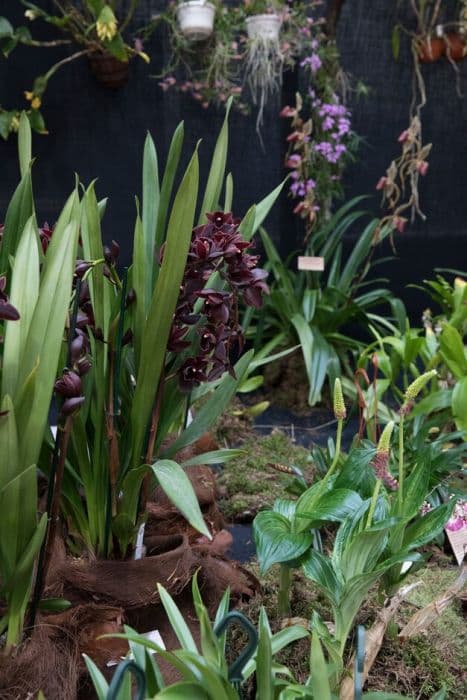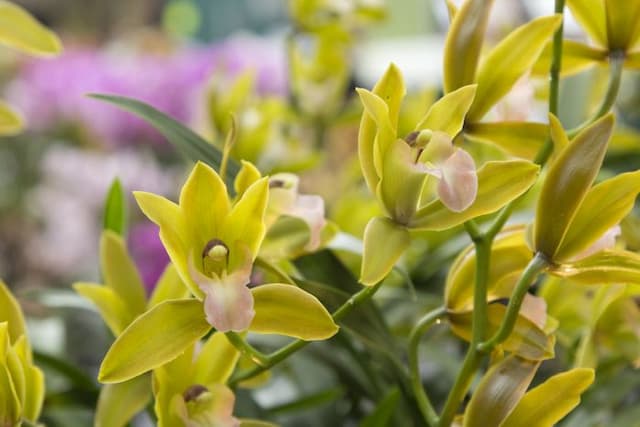Cymbidium Orchid Cymbidium Dorothy Stockstill gx

ABOUT
Cymbidium Dorothy Stockstill, commonly known as a type of orchid, features a stunning array of colors and shapes that make it a favorite among ornamental plant enthusiasts. The plant typically exhibits a robust and symmetrical growth habit, with long, leathery leaves that have a tendency to arch gracefully. The foliage is a deep, vibrant green, providing a lush background for the spectacular flowers. The blossoms of this orchid are particularly striking, often characterized by their large, showy appearance and intricate details. The flowers are typically borne on long, upright stalks that emerge from the base of the plant, displaying the blooms prominently. Each flower spike can carry multiple blossoms, adding to the plant's visual impact. The petals and sepals of Cymbidium Dorothy Stockstill can come in a wide range of colors, including shades of pink, red, yellow, green, and white, often with contrasting markings or patterns such as spots or stripes that enhance their beauty. The lip, which is the most distinctive part of the orchid flower, might be boldly colored or have a different pattern, drawing attention and serving as a landing platform for pollinators in nature. Overall, this orchid has a lush, exotic appearance, with eye-catching flowers that can add a touch of elegance to any setting. Due to their long-lasting blooms, they are particularly prized as cut flowers or as potted plants for interior decoration.
About this plant
 Names
NamesSynonyms
Cymbidium Dorothy Stockstill 'Forgotten Fruits', Forgotten Fruits Cymbidium
Common names
Cymbidium Dorothy Stockstill gx.
 Toxicity
ToxicityTo humans
The Cymbidium Dorothy Stockstill gx, commonly referred to as the "Cymbidium orchid," is generally considered non-toxic to humans. Ingesting parts of this plant ordinarily should not cause any symptoms of poisoning. However, it is always prudent to avoid eating ornamental plants because individual sensitivity can vary, and other non-toxicity related consequences such as allergic reactions could occur.
To pets
The Cymbidium orchid is also generally considered non-toxic to pets. It is not known to cause any significant symptoms of poisoning in animals such as dogs and cats if they ingest parts of the plant. As with any non-food item, ingestion can sometimes lead to gastrointestinal upset or an allergic reaction, but toxicity is not expected from the Cymbidium orchid.
 Characteristics
CharacteristicsLife cycle
Perennials
Foliage type
Evergreen
Color of leaves
Green
Flower color
Mixed
Height
2-3 feet (60-90 cm)
Spread
1-2 feet (30-60 cm)
Plant type
Orchid
Hardiness zones
9
Native area
Asia
Benefits
 General Benefits
General Benefits- Ornamental Value: Adds aesthetic beauty to living spaces and gardens with its striking flower arrangements.
- Long-Lasting Blooms: Known for its long-lasting flowers that can provide color and interest for an extended period.
- Gift Potential: Often given as a gift due to its attractive appearance and the symbolism associated with orchids.
- Low Maintenance: Requires minimal care compared to some other ornamental plants, making it ideal for busy individuals or those new to gardening.
- Habitat Support: Can provide habitat and micro-ecosystems for beneficial insects when grown outdoors.
- Therapeutic Effects: Engaging with plants, including orchids, has been found to reduce stress and improve mental well-being.
- Cultural Significance: In some cultures, orchids are symbols of love, luxury, and beauty, and can be used in ceremonies and traditions.
- Educational Interest: Growing orchids like the Cymbidium can teach patience and the rewards of attentive gardening, offering lessons in horticulture and botany.
 Medical Properties
Medical PropertiesThis plant is not used for medical purposes.
 Air-purifying Qualities
Air-purifying QualitiesThis plant is not specifically known for air purifying qualities.
 Other Uses
Other Uses- Cymbidiums, commonly known as boat orchids, can be used in fashion and jewelry as live plant accessories. The blooms can be delicately attached to brooches or hairpins for a natural, elegant look.
- Boat orchids can serve as a learning tool for botany and horticulture students, illustrating the principles of hybridization and genetic diversity among plants.
- These orchids can be used in photography as a subject for botanical still life arrangements or as a natural backdrop for portrait photography due to their stunning flowers.
- In culinary arts, the non-toxic flowers of boat orchids can be used as edible decorations on cakes and desserts, adding an exotic touch to the presentation.
- During social events and ceremonies, boat orchids can be used as table centerpieces or event decor, bringing a sophisticated and tropical ambiance.
- The orchid's long-lasting blooms make them suitable as tattoo inspiration, representing beauty, luxury, and strength in body art.
- Boat orchids can be used in eco-friendly burial practices, where biodegradable pots with orchids are buried with the deceased as a symbol of ongoing life.
- The flowers can be used in crafting, especially in making handmade paper or pressed flower art, which preserves the beauty of the blooms in a unique medium.
- In the film and theater industries, boat orchids can be utilized in set design to create a specific atmosphere or to evoke a particular time period or location.
- The rigid yet elegant structure of the boat orchid's leaves can inspire design elements in architecture and home decor, influencing patterns and motifs.
Interesting Facts
 Feng Shui
Feng ShuiThe Cymbidium, also known as boat orchid, can be used in Feng Shui to enhance the energy of a space. The plant is associated with growth and perfection due to its symmetrical blooms. It's best placed in areas of the home that require an energy lift or where you want to promote serenity and beauty, such as the living room or family room. According to Feng Shui, boat orchids may also attract good fortune and positive vibes when placed in the wealth or relationship areas of the home, ensuring that the plant is healthy and well-maintained to keep the energy flow optimal.
 Zodiac Sign Compitability
Zodiac Sign CompitabilityThe boat orchid is not used in astrology practice.
 Plant Symbolism
Plant Symbolism- Beauty – Cymbidium orchids are widely appreciated for their stunning flowers, symbolizing exceptional beauty.
- Refined taste – Due to their elegant appearance and long history of cultivation, they represent sophistication and refined taste.
- Love – Orchids are often given as gifts to convey love and affection towards someone special.
- Strength and Virility – In some cultures, cymbidiums represent strength and virility because they are perennials that can withstand harsh conditions while still blooming magnificently.
- Longevity – The long-lasting nature of the orchid's flowers symbolizes a wish for a long and healthy life.
 Water
WaterThe Cymbidium, often known as the Boat Orchid, requires thorough watering. During the active growth season in spring and summer, water the plant about once a week, using approximately one quart of water each time for a medium-sized pot. Ensure that the potting mix is allowed to dry slightly between waterings, but do not let it become completely dry. Reduce watering in the fall and winter to every other week. It is important not to let the Cymbidium sit in standing water, so always allow any excess to drain away to prevent root rot.
 Light
LightThe Boat Orchid thrives in bright, indirect light. It is best placed in a spot where it can receive plenty of light without being exposed to direct midday sun, which can burn the leaves. A shaded southern or an eastern-facing window are typically ideal spots for a Cymbidium orchid to receive the kind of light it enjoys.
 Temperature
TemperatureBoat Orchids prefer moderate temperatures and should be kept in conditions ranging from 50 to 70 degrees Fahrenheit for optimal growth. They can tolerate a slight dip into the high 40s at night and can withstand daytime temperatures up to the mid-80s, but prolonged exposure outside this range can be harmful. For flower initiation, a difference between day and night temperatures is essential, typically with night temperatures around 50-55 degrees Fahrenheit.
 Pruning
PruningPrune the Boat Orchid after it has finished blooming, usually cutting back the flower spikes to the base. This is typically done in the late winter or early spring. Pruning encourages new growth and can help stimulate the next season's flowers. Repotting and removing any dead or decaying roots should be done every two to three years, which also provides an opportunity to divide the plant if it has grown too large.
 Cleaning
CleaningAs needed
 Soil
SoilThe best soil mix for a Cymbidium Orchid, which is the common name for Cymbidium Dorothy Stockstill 'Forgotten Fruits', is a well-draining medium like bark chips, perlite, and charcoal. The ideal pH for Cymbidium Orchids should be slightly acidic to neutral, ranging from 5.5 to 6.5.
 Repotting
RepottingCymbidium Orchids should be repotted every two to three years, or when the potting medium breaks down and no longer provides proper drainage and aeration to the roots.
 Humidity & Misting
Humidity & MistingCymbidium Orchids thrive best in humidity levels between 40-60%. Maintaining these humidity conditions is optimal for their growth.
 Suitable locations
Suitable locationsIndoor
Place in bright light, water weekly, and maintain cool temps.
Outdoor
Partial shade, protect from frost, ensure good airflow.
Hardiness zone
9-12 USDA
 Life cycle
Life cycleThe life of the Cymbidium Dorothy Stockstill 'Freakout', an orchid hybrid, begins with seed germination, which is complex and often symbiotic with a mycorrhizal fungus. Following germination, the orchid develops into a protocorm, which is a small, round plantlet that gradually differentiates into shoots and roots. As it matures, foliage develops into long, strap-like leaves, and the plant establishes a strong root system. The orchid reaches maturity and enters a vegetative growth phase, during which it concentrates on leaf and root development. Flower spikes emerge from the base of the pseudobulbs, typically in the cooler months, leading to the blooming stage where intricate and colorful flowers are displayed. After pollination, the flowers fade, and seed capsules develop and eventually disperse, restarting the life cycle; meanwhile, the plant continues vegetative growth and can be divided for propagation.
 Propogation
PropogationPropogation time
Spring-Early Summer
Cymbidium Dorothy Stockstill, commonly known as the 'Forget Me Not' orchid, is generally propagated through the division of its pseudobulbs—the storage organs that appear as swollen portions at the base of the plant. The ideal time to propagate this orchid is after it has finished flowering, typically in the spring. Once a cluster of pseudobulbs has grown large enough, usually comprising about four mature bulbs, it can be divided. To do this, the orchid is removed from its pot, and the root mass is gently untangled and cleaned. Using a clean, sharp knife or shears, the grower cuts the clusters of pseudobulbs apart, ensuring that each division has at least one back bulb—the older, non-flowering pseudobulb—along with at least one or two front bulbs that possess the potential to flower. Each division is then potted in fresh orchid potting medium, and with proper care, they should go on to thrive and produce new blooms in future seasons.









